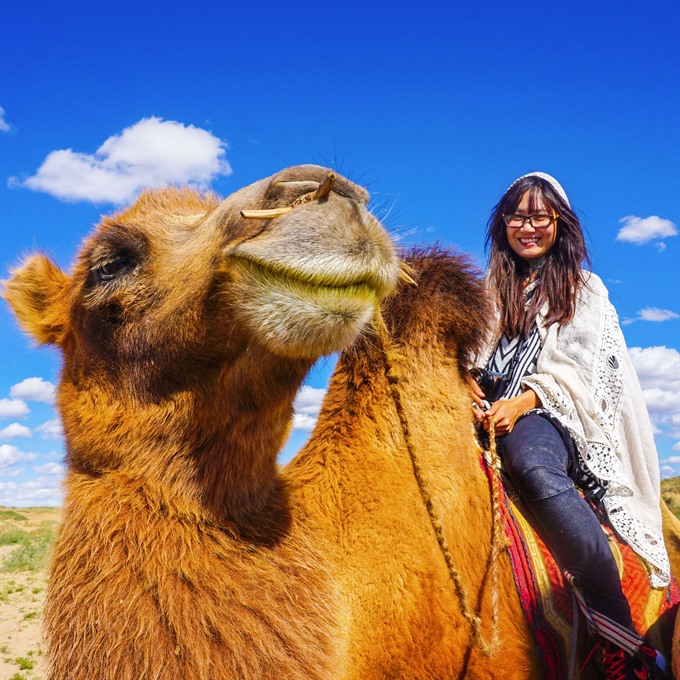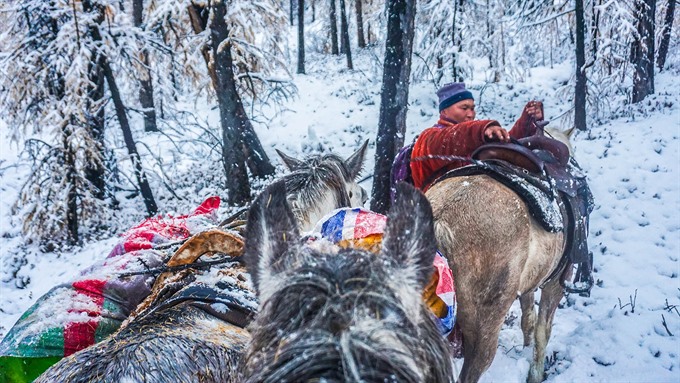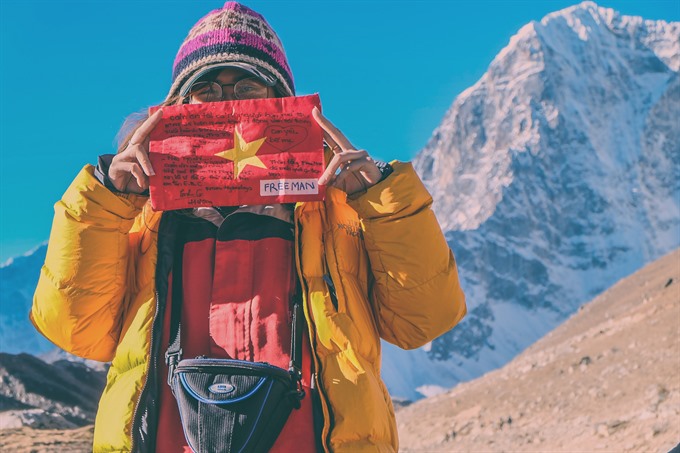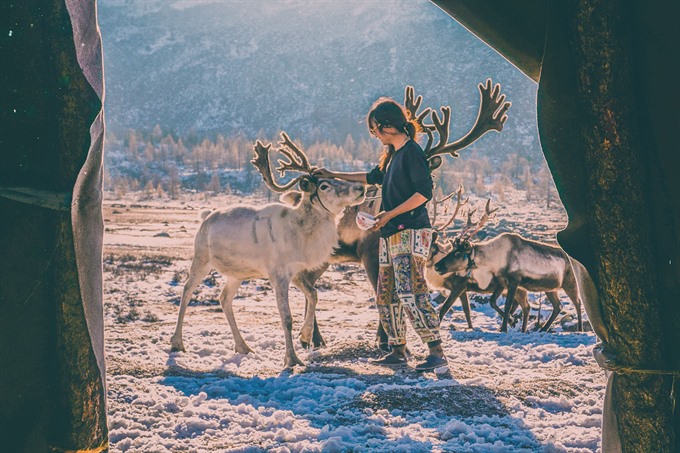Viet Nam News
Pham Mai Huong quit a regular job to travel full time, and is rewarded with a once-in-a-lifetime experience in northernmost Mongolia with the Tsaatan tribe. Hong Van reports.
Pham Mai Huong is not a globe-trotter, but for someone who began travelling abroad just a year ago, she has gone places.
The 26-year-old native of the northern province of Hoa Binh studied literature in Da Nang, and began working at her alma-mater on completing her graduation.
Three years later, she decided to quit.
“Giving up a stable job to pursue my passion for travelling was a big turning point in my life,” said Huong.
“I was fed up with a life in which I would do the same thing every day, in which people had to please everyone. And I asked myself why do I have to live a life where I am not myself, live a life to please other people.”
Meanwhile, Huong’s family was proud of her work in a State-run university and felt that her travelling to ‘strange’ destinations was “risky and not appreciating life and herself”.
“Seeing that my family and acquaintances were proud of my work at university restrained my wanderlust.”
“But the passion grew bigger each day and I felt like just mentioning travel would make me burst into tears.”
 |
| Smiles all around: Huong traveled through the Gobi desert in Mongolia for 12 days. |
Finally, Huong wrote a resignation letter to her director, and then another — one that required more determination — to her parents.
“Only by travelling can I live to the fullest. I have decided that I will live a life that I would not have to regret when I look back,” she wrote.
Once this decision was taken, she did not just up and away. She’d already travelled throughout Viet Nam, and had particular interests in other places and cultures.
“My first foreign country was Nepal. Some people said my choice was quite ‘strange’. They said it has more sense to choose some Southeast Asian countries with cultures similar to Viet Nam so as to gain some travelling experience first, and then go to farther lands.
“For me, the distance or difficulties along the way are not an excuse to postpone the journey.”
In Nepal, she discovered Kathmandu and she climbed up to the first base camp of Mount Everest, an impressive feat in itself.
To cover her travelling expenses, Huong works as a freelance writer, photographer and video maker. She also manages a small business online for extra income.
"In my journeys, I also work as volunteer to save money for accommodation and meals. It gives me a chance to experience local life and meet volunteers from other countries.”
 |
| On the way: From Tsagaan Nuur to Tsaatan tribe, Huong was on horses with her guide, passing by taiga forest and three mountains covered with snow. |
Last chance
It is her next trip, to Mongolia, that sets Huong even further apart from a normal traveller, and shows that her travelling goes beyond seeing new places.
“I have long had a special interest in the indigenous cultures and lifestyles that are on the verge of disappearance. The fact that the indigenous cultures may disappear in the near future urges me to travel to these lands.
“I am afraid that if I hesitate, I may not have chance to see eye-on-eye these cultures and experience their lifestyle firsthand,” said Huong.
Thus it happened that the trip to Mongolia turned out to be a once-in-a-lifetime experience
First, she made a 12-day trip through the Gobi dessert, and another trip 10 days to meet with the Tsaatan tribe.
“In Gobi, I came to love the nomadic lifestyle of locals as well as the pristine and quiet landscape.
“My journey to be with the Tsaatan tribe, a remote and detached area in this world, will be the most memorable experience in my life.
“It was full of challenges, exhausting and above all, a once-in-a-lifetime experience,” said Huong.
“It was an incredibly emotional moment for me, when they said that it was the first time they were meeting someone from Viet Nam and the first time a Vietnamese visited their tribe and stayed with them like I did.”
201103039AM.JPG) |
| Saying graze: In the morning, the Tsaatan people lead reindeers to the mountain and return home in the afternoon. |
Huong chose the Tsaatan tribe in Mongolia after reading that they are on the verge of disappearance.
“I decided to meet them, experience their life and record it through photos and videos,” said Huong.
There were difficulties at first in terms of information as it seemed no Vietnamese had ever visited the Tsaatan tribe and written about it. There was no writing about such a journey even by foreigners, said Huong.
Huong began the journey in August last year, travelling thousands of kilometres. Huong and Norda, a Polish woman she befriended in Mongolia, travelled nearly a thousand kilometres by bus from Ulaabaatar to Moroon and then from there to Tsagaan Nuur.
“The 300-kilometre trip from Moroon to Tsagaan Nuur in a 10-seater car was the worst I’ve experienced. It was cramped with 16 people and loads of luggage, and the passengers squeezed and elbowed.”
It took nearly 16 hours to cover 300 kilometres, because of the rough and muddy roads.
From Tsagaan Nuur to reach the Tsaatan tribe, Huong travelled on horse with her guide, passing through a taiga forest and three mountains covered with snow.
“I still remember it was 9:30pm, everything was getting darker. I was surrounded by the endless whiteness of snow. The pine trees with golden leaves were also covered with snow, and it gave the whole scene a haunting feeling,” said Huong.
That night Huong, Norda and their guide stayed overnight in an abandoned stable near the jungle, experiencing extreme coldness.
“The freezing temperature in the taiga was scary,” said Huong, who spent three nights in tents in minus 20-C degree temperatures. Every hour, she got up to keep the fire burning.
 |
| New heights: Huong poses at Gorak Shep in Nepal, which is 5120 metres above sea level. |
“Meeting with the tribe and seeing their teepee tents and the barks of Huskies, I had so many feelings. Bursting with happiness. Hopeful. Anxious. And eager. Everything was like a dream.”
“When we walked into a tent, the owner, 46-year-old Baigali welcomed us with a warm smile and fed us with reindeer’s milk and cake,” said Huong.
Currently the Tsaatan tribe has 70 families, 30 of whom live in the eastern part of the taiga and the rest in the west. They live close to each other in summer and would separate in winter to guarantee that there is sufficient food for the reindeers. Each family then lives three to four mountains from each other.
In the morning, the people would lead reindeers to the mountain and return home in the afternoon. Tsaatan people live in grey tents called yurt or gers that are covered with waterproof leather. There is a fireplace with a chimney for burning wood. There are two small beds and a small area to store food and wood.
Huong then followed Baigali’s family as they took the reindeers to the snowy mountains, let them eat grass and pine nuts. She listened as they sang traditional songs of the tribe.
“That moment when I was standing on a snowy mountain, surrounded by reindeer leisurely enjoying munching on grass, I felt like my soul had become pure and was free of any burden," she said.
“I was also strongly impressed with their hospitality. They would share with me whatever they had – milk, cheese, cake, pine nuts.”
By the third night, tired and weary of the extreme cold of her own tent, Huong asked to stay with a local Tsaatan family and was hosted with “great warmth".
“Before going to sleep, we sat around to enjoy pine nuts and the family sang their songs. That was one of the most beautiful memories for me,” said Huong.
On the morning of the fourth day, just as Huong was getting out of the tent, she realised that the nearby tents had been dismantled. She learnt that it was time for them to move to other places to find food for reindeer.
They got on the back of their horses and waved at us, smiling. And I still carry their smiles.”
 |
| Dear deers: Pham Mai Huong, 26, travelled through forests and mountains to meet and stay with the Tsaatan tribe in northeastern Mongolia. —Photo Courtesy of Pham Mai Huong |
Self-discovery
Her future plans include travels to Iran, Egypt and some tribes in Africa, not to mention rediscovering the ethnic minorities in Viet Nam, especially little-known ones.
Set on a new path, Huong said: “I will never regret my choice. I understand that the road leading to a dream is never easy. The only thing that hurts is that until now my family are still unhappy with my choice. It hurts when I see their tears. That’s the biggest price I’ve had to pay for this choice.
“I will try my best so that my family will be proud of me in a way other than they were for my previous work with the university.
“These journeys have given me the experience and opportunity to discover myself and be myself. While the destinations that I chose have been tough and challenging, I have realised my heart is bigger than I thought.
“The more I travel, the more I see, the bigger the love I have for life.” VNS